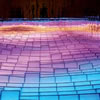Here are some basic rules of psychological behavior of human perception to better understand the mechanisms of the images. You need to understand how our brain decodes reality, and how synthesizes information or how the mind fills the information.
For us, the visual artists, it is important to know that the forms that are equal will generate an internal force in the picture, by the tendency of our minds to unite and relate, which affect expression of the work.
So do the lights, the shapes, the lines and the directions, and many other visual elements, because they do not play alone, but in the whole.
Not only do the colors affect each other on the canvas. So do the forms and, thank to the study of them, we can better understand their role in the image.

* Example of image reconstruction by the brain, which clearly sees a letter A. (Experience rule, because who learns to read even recognizes the fragmented letters)
BASIC RULES OF HUMAN PERCEPTION IN RELATION TO FORMS:
1 – Rule of proximity.
Identical visual elements that are closely are combined visually, creating a unit.

2 – Closed shapes rule.
To our mind, the shapes with a closed path are easier to see as a unit. When forms are not closed, the mind completes the form until he receives something known. You can clearly see a black box above.

3 – Unity rule.
The identical elements organize a unity or relationship.
Examples of relationships of equality:
- 3-1.The parallel lines on a background . Parallel lines generate a unit block background. Therefore, the curved lines are always displayed above, in the foreground.

- 3-2. The symmetric sections forming a figure.

- 3-3. The elements of the same size are combined.

- 3-4. Elements with the same luminosity are equal.

4- Solid line rule.
A shape, with a profile or contour line completely around hiem, it´s easier to perceive as a unit. Especially if they are common forms. By overlaying two circles, for example, if the overlap is too big or too small, it becomes difficult to get the difference between figure and ground.

The solid line forms a closed figure
4.1 – Two overlapping circles or two moons are facing. The drawing is on the edge of both ideas.

4.2 – Now we see two overlapping circles. Being larger space, the idea of the 2 moons disappears.
5- Tendency to three-dimensionality.
Familial forms may seem three-dimensional.

Even with incorrect shapes the brain tries to see the depth effect, because it relates everything with the known reality.

6 – Experience rule.
We can add the missing parties to the figure thanks to our experience, if we already know the figure.

7 – Equation tendency
That is, to recognize similar shapes. If we have an image with many different patterns, they say we can differentiate 7 shapes, and the rest will be grouped with their most similar. Our brain synthesize information, so, more than 7 different shapes will not be appreciate. It is advised not to use more than 7 elements of very similar shapes.

In this picture the brain quickly associates the most similar shapes, in an exercise of simplifying the image, without seeing that each one is different.
8 – Background – figure relationship Rules.
There are many rules inside this one…
For example, the contrast with the background: Big contrast generates clearer figures.

A little contrast with the background dilutes the forms and shapes and creates environments or atmospheres.

In summary, every form exists in relation to its background. The most obvious is the separation or contrast between figure and ground, plus highlight the figure to its environment.
Enough for today … … buf!








